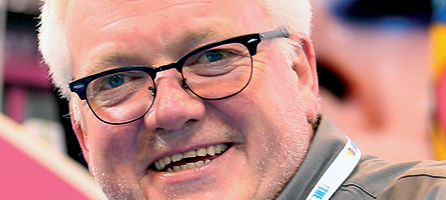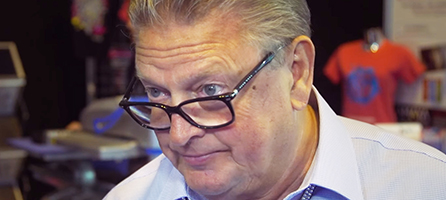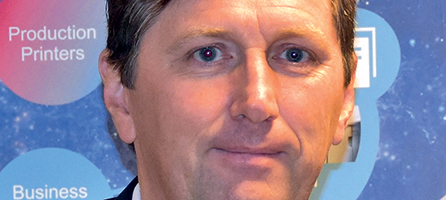
Heather Kendle, market development manager production, professional printing solutions, Epson Europe
Digital textile printing currently accounts for only two to 3 percent of a 33 billion square metre global textiles market, but it is a sector enjoying strong growth, fuelled by access to affordable and effective technology, a widening choice of fabrics, and demand from customers for choice of style, colour, fabric, and cut. Epson offers both dye-sublimation and direct-to-garment (DTG) printers.
Printers and sign-makers with online or web-to-print services will find textiles a very attractive market, which will allow them to broaden their business. Opportunities are not just in soft signage and promotional merchandise, it will also allow them to satisfy the growing interest from young designers and end-users to create bespoke garments from sportswear to high fashion, and home furnishings.
Indeed, dye-sublimation would also allow them to produce high-end promotional merchandise, including mugs, key fobs, coasters, as well as flags, banners, and permanent corporate signage. It is a highly creative sector and one where the entry cost is low.But there is a growth path, because for those who reach industrial level output, we can also offer migration to the Monna Lisa high capacity production presses, produced in Italy by Epson subsidiary Robustelli. The range of polyester-based or -coated materials available for dye-sublimation have evolved considerably in recent years and are now able to emulate natural fibres like silk, suede, or cotton. Dye-sublimation provides vibrant and long-life results, because the ink penetrates the fibres rather than coating the surface.

It is a highly creative sector and one where the entry cost is low, but there is a growth path”
Epson has a 45 percent market share (Infosource) in the dye-sublimation printer market and the products it offers come under the Epson Sure Color SC-F banner. There are two 64? models, the high-end SC-F9200 and the medium- to high-volume model SC-F7200. The smaller 44? SC-F6200 is ideal for low and medium run production.
The technology is there, the market is ready so printers should grasp the opportunities available with dye-sub and DTG technology.
More than t-shirts

Jim Nicol, managing director, The Magic Touch
The Magic Touch, with over 25 years’ experience of garment decoration using their image transfer process, continue to offer affordable solutions covering many aspects of the promotional, workwear, sportswear, and fashion markets. Over the past decade, the industry has seen the introduction of various DTG printer options ranging from the high-end Kornit brand to a selection of modified Epson based entry-level printers. The only real issue has been picking the right one to match the expectations and demands of the purchaser.
Over that same period, the ability to decorate a wider range of garments such as dark colours, polyester, and performance fabrics has improved, but the process still requires some form of pre-treatment process to ensure consistent results. Today, with built in pre-treatment options available and with the new ‘hybrid DTG’ technology making many of the existing DTG machines obsolete in terms of innovation, these are significant times for those involved in the supply chain. However, at the same time there is a price to pay for this new innovation and it is important to get the decision right with many machines starting at £10,000 rising in excess of £100,000 in many cases.

Potential purchasers of DTG need to fully understand what the DTG can and cannot do”
Potential purchasers of DTG need to fully understand what it can and cannot do, preferably before they make the purchase. Plus, they need to ensure they have the sales and marketing in place to ensure products are sold at the right price to ensure a real return on the investment.
The personalisation market continues to grow and is expected to double over the next five years, but this will apply to almost every aspect of personalisation.
The Magic Touch has enabled users to grow their businesses profitably by helping them create new customers who are offered more choice. This is highlighted by the strong growth over recent years of short-run production of umbrellas, cushions, bags, holdalls, phone accessories, notebooks, and much more together with garments. We offer transfer solutions and continue to support all products and applications with their outstanding technical and customer support.
Direct to profits

Peter Wright, managing director, Amaya Sales UK
Amaya Sales specialise in the supply of Melco embroidery machines, Polyprint Texjet direct-to-garment printers, Forever transfer paper, Sef garment film and vinyl, together with associated software and accessories. We provide a complete service to the embroidery and digital print garment industry, from small business start-ups to large established set ups. Our fully experienced team have over 30 years’ experience in the industry and have the expertise to help and advise in all aspects of the business.
The most recent development is that we have become a UK distributor for Kornit, which completes a collection of top of the range brands in the garment decoration industry. We will grab the chance to promote the leading Kornit range of products with both hands. On the digital print side of our business, we will now be able to offer equipment to companies ranging from small right up to the largest high production printing requirements. It will be an honour working with such a prestigious company, and we look forward to our future relationship.
Texjet, manufactured by Polyprint, is a leader in its field of direct-to-garment printers. Polyprint’s experience, gained during 30 years in the industry, is the strong base of knowledge that allowed the company to embrace digital technology in 1998. They started offering solutions for digital direct and transfer printing on textiles, evolving in the next years to one of the leading companies specialised in the field.

We will grab the chance to promote the leading Kornit range of products with both hands”
The development of the Texjet direct-to-garment printer, which was initially released in 2005—being one of the first printers of its kind worldwide, was a positive response to the market’s demand for a quick and flexible t-shirt printing solution.
If it is garment film/vinyl that you are looking for then our Sef products are second to none. Sef garment film products are manufactured using water-based formulations, with no solvents, completely safe for the environment and carry the Oeko-Tex certificate. We offer a full range for all applications including flock and Meta Flex.
Our customers always come first. They range from the small home-based business to various sizes of commercial companies right up to the largest manufacturing companies, which have a need for embroidery and printing as part of their business, such as screen printers, promotional clothing, marketing companies, sign companies, engravers, sports clubs, and school and sportswear companies, to name a few.
In today’s market, the need for ever increasing levels of efficiency in production means that ‘downtime’ is very costly. We aim to supply our customers with a range of benefits to achieve their production targets.
A brand new horizon

Erwin Busselot, business innovations and solutions director, commercial and industrial printing, Ricoh Europe
Ricoh is committed to the continuing success of print-service-providers. Thanks to the continual development of our own Ricoh print head technology and the expanding range of substrates, new applications are increasingly accessible to print-service-providers. Garment printing is a perfect example of this. It is where technology meets creativity.
With our Ricoh Ri 6000 series, customers benefit from an improved workflow compared to the conventional analogue textile printing technique. The highly productive Ricoh direct-to-garment printers take just a few steps to print on a finished piece of textile such as a t-shirt, cloth bag, or sweatshirt. The production workflow is simplified further with AnaRIP, which includes last minute editing, white ink management and ink estimation tool.
We have seen the shift of analogue to digital print technology in various markets such as graphic arts. Now, something similar has started in the garment decoration market. There is increasing demand for high quality output, delivered just-in-time and with no minimum order quantities. Direct-to-garment print is only touching the surface right now. The expanding promotional and personalised goods market means that the digital opportunity is huge.

We have seen the shift of analogue to digital print technology in various markets”
Creating a new revenue stream sounds interesting and seems easily achievable with investment in new hardware. But that is only partly right. There are several elements that need to be streamlined to deliver to a print-service-provider’s client the service experience required nowadays. Before the investment, consider the following. What are the manual steps in my workflow to deliver that sweatshirt tomorrow? Am I capable of making personalised t-shirts efficiently? How do my future clients become aware of my new textile offering?
The right combination of hardware, software solutions, and a trusted partner is the key to success. Ricoh is ideally positioned to help our customers grow by supporting the end-to -end workflow—from order entry through the production process and to delivery.
Your text here...